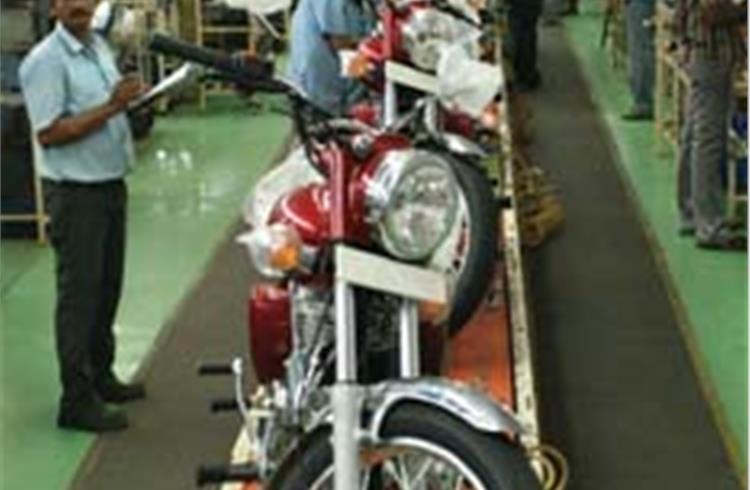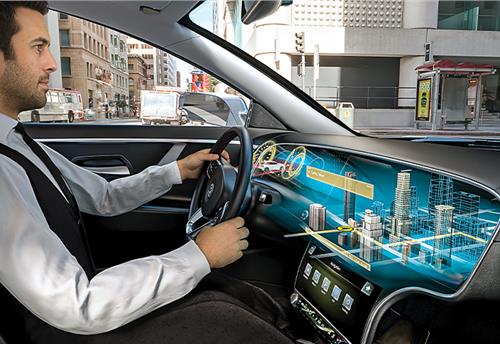Royal Enfield puts solid building blocks in place
The two-wheeler company is in the midst of an important restructuring exercise, report Murali Gopalan & T Murrali.
On the contrary, its factory is located in the midst of one of the oldest parts of the city, Tiruvottiyur which is better known for its heavy truck traffic. The serene part about the place is the sea though this is a different ballgame during the rains when this low-lying area faces the brunt of nature’s fury.
It is here that RL Ravichandran and his enthusiastic colleagues are working on a vision that will see the company emerge financially stronger and put out more bikes in the next couple of years. The chief executive officer is still remembered for his stints at Bajaj Auto and TVS Motor where his skills in marketing came to the fore. He acknowledges that they were tremendous learning grounds and that the experience he acquired holds him in good stead today.
PASSION AS THE DRIVER
Ravichandran took charge at Enfield nearly two years ago. “It was a decision based on sheer passion which is shared by some of my colleagues and dealers. My first bike was a Bullet which I used for nearly a decade,” he recalls. As he puts it, the first task on hand was to understand how the company was still surviving despite small volumes. Two, did it have the potential to do better? It was clear that a lot of hard work was necessary to put the house in order. After all, it was going to be a challenge dealing with virtually an ancient entity which was still rolling out a cult motorcycle.
One important observation was that there had been no big change in the product simply because buyers were not complaining. “If you are not driven by competition, you might lose your sensitivity to the market,” Ravichandran says. Obviously, he knows what he is talking about having played the market share game through his career. However, this was not the need of the hour at Enfield given its small volumes. Even if sales were to double, it was not going to create headlines in terms of market share simply because of the overwhelming numbers in the industry.
The peculiar trait of the Bullet buyer lies in the fact that he is ready to buy the product and does not require any hard sell talk. Of course, the company’s dealers do their job, as is the case for any other mass product in terms of finance, advertising etc. Ravichandran and his think-tank were keen to understand if the company was delivering what the consumer wanted. What they found from research is that nearly 95 percent of the sales came from Royal Enfield’s original design (the traditional model). This was food for thought!
He was also often asked by peers in the industry why the company was not keen on making bikes that could compete with the likes of the Pulsar or Apache and consider bigger numbers in the bargain. Clearly, this was not possible because of the unique technology and engine architecture of Enfield which is based on push road and valve. The only other manufacturer which uses this in a big way is Harley Davidson.
Ravichandran says that people buy his company’s bikes for the attributes it offers in the form of its size, power and speed. Interestingly, there is a set of tourists from Europe who come to India every year, buy Enfield motorcycles and travel across the length and breadth of the country only to sell them before heading back home! “The belief that Enfield’s character is critical to grow the company must be equally convincing to people working here. They should have faith in this business model even though there could be doubts on the likelihood of making money at these small volumes,” Ravichandran says.
The fact is that this is precisely what is happening. Cash profits are a reality today and clearly, there is a greater sense of buoyancy within the company. “Belief in the longevity of our bikes is mandatory. Whatever new product we make should reflect the character of Enfield. This was the first premise. Two, being a small company, our cost of running the place was as high as a bigger entity. This was suicidal. Cost-control was imperative,” he says.
##### CHALLENGE OF HIGH COSTS
Making a bike at Enfield is not an inexpensive proposition and this turned out be a tough burden to bear in 2005-06 when prices of raw materials like aluminium, copper, steel and zinc shot though the roof. Quite unlike bigger players who have the luxury of cross-subsidising products (because of a larger range in their stable), Enfield has no such luck. “Our bikes are the heaviest in metal content which means that there little we can do when prices go up. We cannot demand reductions from suppliers because of low volumes,” Ravichandran explains.
The challenge was to balance costs with small volumes and the priority was to check out reasons for the high costs. The main problem was lack of quality, discipline and systems. For the record, nearly 70 percent of material costs are outsourced. The permanent workforce at Enfield is about 650 which is divided almost equally between workmen and executives/staff. Despite being a small company, certain functions are inevitable in terms of finance, sales & marketing, materials, canteen, maintenance, product development etc.
As part of the cost-control exercise, two teams of ten people each were created within the company. They were from different functions like R&D, manufacturing, quality etc whose mandate was to constantly check out product cost reduction through value-engineering, alternative sourcing and different thinking without changing the basic character and image of Enfield. “This was important and the results have been encouraging. We looked at many ideas for their viability and implementation. The team has been working relentlessly towards meeting this objective. What began as a one-year target is now up to two years because of huge inflow of ideas,” Ravichandran says.
There have been some major successes and, as he adds, the team worked on an effective system of removing expensive components. For instance, the electric start (which was not too reliable) has a mechanism which involves 12 parts and was pushing up costs. The team targeted removing 50 percent of the parts and making it a simple system without compromising on quality. “We are in the final stages of trial and it will be launched soon. The savings have been quite substantial,” he says.
This was not all. As Ravichandran explains, in any old company like Enfield, indirect losses are heavy and not accounted for. There is a lot of metal work, especially on the petrol tank which is still made by hand. Even its painting is hand-drawn.
##### VENDORS DO THEIR BIT
In the process, hidden costs associated with making the tank by hand are sometimes more than the cost of the tank itself. This is because getting one right could mean rejecting three others. “We wanted to find out if there was a way to make it like any mass manufacturer. As luck would have it, we have vendors who wanted to prove that they could do it. The tank was the second project. We have succeeded in making ten percent of the production in a new way and in five months, this will be 40 percent,” he says confidently.
The ‘new way’ literally means that it is on the lines of what is done elsewhere in terms of being pressed, machined, polished etc. Royal Enfield still makes conventional parts and castings and the team’s mandate was to think of better alternatives. The old, error-prone gravity die-casting method which contributes to indirect costs will soon be replaced by pressure die-casting which will assure better finish with lower defects. “We are taking six parts towards that route,” he says.
The revamp exercise began in January and the results could be achieved by April next year. As Ravichandran says, while there are any number of people who want to ride a Bullet, the actual numbers are lesser. One reason for this is the phobia associated with fixing the bike for defects. “If we change its features, it will cease to be a Bullet. We collected feedback and got some interesting findings which reflected severe quality issues but were still being accepted by buyers. They just wanted the fundamentals right,” he says.
GETTING A FIX ON THINGS
What were these fundamentals? Electricals, brakes, engine seizures, petrol tap leaks, clutch, shock absorbers were some of them. It was important to fix these first. The CEO termed this exercise the 100 irritants removal plan. It was not as if this would eventually lead to mass buying but the idea was to make customers happier who, in turn would spread the good word. “We do not want to touch anything connected with noise and beat because it will involve redesign. The team has been outstanding. We identified 122 points for rectification and 88 have been implemented. At least 20 will follow in the next 3-4 months and the balance in due course,” he says.
The results are beginning to show in the form of happier customers, dealers and vendors. Ravichandran believes that the benefits of this learning will be apparent with the new engine which is being tested and will be out in the market this calendar. It will comply with Euro 3 norms that are mandatory in overseas markets. According to him, there has been a huge change in employee morale. The company is in a situation where demand is chasing production and there are virtually no stocks. TPM, as a philosophy, is now part of Enfield with work happening on three 3 fundamental methods.
The focus for this year is to achieve daily production of 120 bikes in the first quarter, 130 in Q2 and 150 units in Q3. The company is now looking at making 50,000 bikes annually in a couple of years of which exports could take up a larger chunk than the present level of ten percent.
CREDIT GOES TO THE PEOPLE
“This is significant for a small company and the credit goes to the people. There have been challenges in the form of high attrition rates but then there are a whole lot of replacements too. This shows that people are interested in working for us but we constantly ensure that they have the passion for our products. There have been many new people here in critical functions and a good mix is happening as a result,” Ravichandran says.
There were talks doing the rounds about a strategic partner for Enfield but for the moment, the idea is to go it alone. Of course, it will help if there is a strategic ally who can add value in terms of systems. The other plant at Jaipur has been dormant but for the moment, the capacity at Tiruvottiyur will suffice for the moment. There are neither benefits in Jaipur in the form of tax-holidays nor is it an auto hub.
Of course, the present location in Chennai has its set of disadvantages and it possibly makes sense to move out to a more vibrant part like Maraimalainagar. However, Ravichandran says that nothing of the sort is being planned simply because there is no need to with the present capacity. And the show goes on!
RELATED ARTICLES
BluWheelz to 'Green Up' logistics sector
With their EVs-as-a-service solution, the startup is playing it smart with costs and looking to electrify the entire seg...
BRANDED CONTENT: Spearheading the EV revolution in India
Jio-bp is a joint venture between Reliance Industries and BP PLC where both entities have married international expertis...
Qualcomm devises cost-effective ADAS chip for India
The American technology giant is enabling connectivity in modern cars and aims to tap into the price-conscious Indian ma...





 By Autocar Pro News Desk
By Autocar Pro News Desk
 04 May 2007
04 May 2007
 4243 Views
4243 Views









